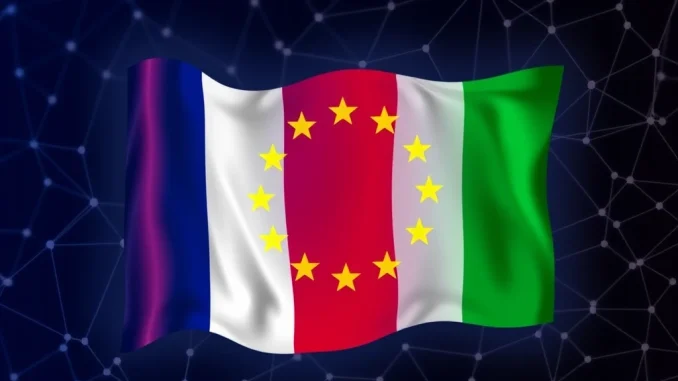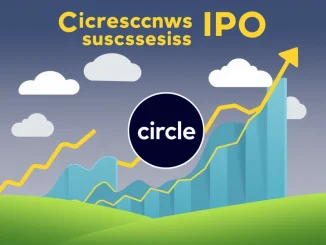
Are you ready for a potential paradigm shift in how blockchain technology is regulated in Europe? Buckle up, crypto enthusiasts, because France and Italy are taking a proactive stance! In a move that could significantly influence the future of digital assets across the continent, the French and Italian financial watchdogs have jointly submitted crucial recommendations to the European Commission concerning the application of Distributed Ledger Technology (DLT). Let’s dive into what this exciting development means for the blockchain space and why it’s grabbing headlines.
Unveiling the Vision: A Flexible DLT Regulatory Framework for Europe
The core of the proposal from the French Autorité des Marchés Financiers (AMF) and the Italian Commissione Nazionale per le Società e la Borsa (CONSOB) is the urgent need for a more adaptable and forward-thinking DLT regulation Europe. Current regulations, often designed for traditional financial instruments, can stifle the innovation and potential of blockchain. Recognizing this, the regulators are advocating for a framework that nurtures growth while ensuring investor protection and market integrity. But what exactly are they suggesting?
Key Recommendations Shaping European Commission DLT Strategy
The recommendations aren’t just vague suggestions; they are concrete proposals aimed at refining the regulatory landscape. Here’s a breakdown of the key points:
- Embracing Flexibility: The regulators are pushing for a regulatory structure that is inherently flexible. This means moving away from rigid, one-size-fits-all rules and adopting an approach that can adapt to the rapidly evolving nature of digital ledger technology EU. This flexibility is crucial to accommodate the diverse applications and innovations emerging within the DLT space.
- Expanding Pilot Programs: Pilot programs are essential for testing and understanding new technologies in a controlled environment. The AMF and CONSOB are recommending an expansion in both the scope and duration of these programs. This would allow for more comprehensive testing of DLT applications across various sectors and use cases, providing valuable real-world data for informed policymaking.
- Strengthening ESMA’s Role: The European Securities and Markets Authority (ESMA) plays a vital role in harmonizing securities regulation across the EU. The recommendations propose bolstering ESMA’s regulatory responsibilities specifically in the context of DLT. This could mean giving ESMA greater authority in setting standards, providing guidance, and overseeing cross-border DLT activities, ensuring a consistent approach across member states.
Why This Matters: The Potential Impact of France Italy DLT Initiative
This joint initiative from France and Italy is significant for several reasons. Firstly, it highlights a growing consensus among European regulators about the transformative potential of DLT and the need for tailored regulation. Secondly, the combined influence of France and Italy, two major economies within the EU, lends considerable weight to these recommendations. When these two powerhouses speak in unison, the European Commission DLT strategy is likely to take notice.
But what are the potential benefits of implementing these recommendations?
Benefits of a Progressive Blockchain Regulatory Framework
- Fostering Innovation: A flexible regulatory environment can act as a catalyst for innovation. By reducing regulatory uncertainty and providing clear pathways for development, it can encourage entrepreneurs and businesses to explore and build upon blockchain regulatory framework.
- Attracting Investment: Clear and supportive regulations can make Europe a more attractive destination for DLT-related investments. Companies and projects are more likely to thrive in jurisdictions where the rules are transparent and conducive to growth.
- Enhancing Competitiveness: By embracing DLT innovation, Europe can enhance its global competitiveness in the burgeoning digital economy. A progressive regulatory stance can position the EU as a leader in the development and adoption of blockchain technologies.
- Investor Protection: While fostering innovation, the recommendations also emphasize the importance of maintaining investor protection. A well-designed regulatory framework can strike a balance, ensuring that investors are safeguarded without stifling technological advancement.
Challenges and the Road Ahead for DLT Regulation
While the recommendations are a positive step, the path to implementing a new blockchain regulatory framework is not without its challenges. Harmonizing regulations across 27 member states, each with its own legal and financial traditions, is a complex undertaking. Furthermore, ensuring that the regulations remain adaptable in the face of rapid technological advancements requires ongoing dialogue and flexibility from all stakeholders.
Moreover, the specific details of how these recommendations will be translated into actual policy by the European Commission remain to be seen. The Commission will need to consider these proposals carefully, engage in consultations with various stakeholders, and navigate the political and practical complexities of EU-wide regulation.
Actionable Insights: What Does This Mean for You?
For businesses and individuals operating in the crypto and blockchain space, this development is a significant signal. It indicates a growing recognition among European regulators of the need to move beyond outdated regulatory models and embrace a more nuanced approach to DLT. Here are some actionable insights:
- Stay Informed: Keep a close watch on developments coming from the European Commission regarding DLT regulation. Follow announcements from ESMA and national regulators like AMF and CONSOB.
- Engage in Dialogue: Participate in industry consultations and discussions related to DLT regulation. Your voice and expertise are valuable in shaping the future landscape.
- Prepare for Change: Anticipate potential changes in the regulatory environment and ensure your projects and businesses are adaptable to evolving requirements.
- Explore Pilot Programs: If you are developing innovative DLT applications, consider participating in pilot programs to test and refine your solutions in a regulated environment.
Conclusion: A Pivotal Moment for European DLT
The joint recommendations from French and Italian regulators mark a potentially pioneering moment for DLT regulation Europe. Their call for a more flexible, pilot-program-driven, and ESMA-supported framework signals a willingness to embrace the transformative power of blockchain technology. While the journey to a fully realized new regulatory landscape is still ongoing, this initiative is undoubtedly a crucial step in the right direction. It holds the promise of unlocking greater innovation, attracting investment, and solidifying Europe’s position in the global digital economy, all while striving to protect investors in this exciting and rapidly evolving space. Keep watching this space – the future of blockchain in Europe is being shaped right now!



